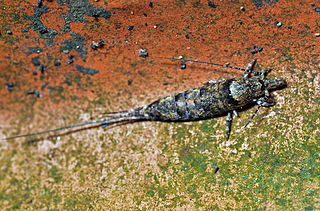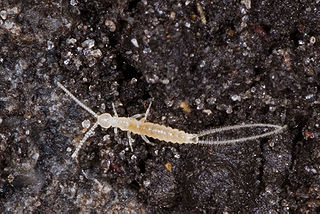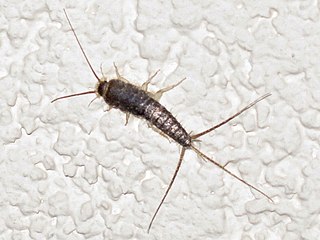
The Machilidae are a family of insects belonging to the order Archaeognatha. There are around 250 described species worldwide. These insects are wingless, elongated and more or less cylindrical with a distinctive humped thorax and covered with tiny, close-fitting scales. The colour is usually grey or brown, sometimes intricately patterned. There are three "tails" at the rear of the abdomen: two cerci and a long central epiproct. They have large compound eyes, often meeting at a central point. They resemble the silverfish and the firebrat, which are from a different order, Zygentoma.
Allopsontus is a genus of the family Machilidae which belongs to the insect order Archaeognatha. Certain species in this genus have been found as high as 5 kilometres above sea level on the Himalayas.
Charimachilis is a genus of the family Machilidae which belongs to the insect order Archaeognatha. They are found in southern and eastern Europe.
Machilinus is a genus of rock bristletails in the family Meinertellidae. There are about 17 described species in Machilinus.
Mesomachilis is a genus of jumping bristletails in the family Machilidae. There are about six described species in Mesomachilis.
Pedetontus is a genus of jumping bristletails in the family Machilidae. There are about 10 described species in Pedetontus.
Petridiobius is a genus of jumping bristletails in the family Machilidae. There are at least two described species in Petridiobius.

Trigoniophthalmus is a genus of jumping bristletails in the family Machilidae. There are about 11 described species in Trigoniophthalmus.

Rhabdura is a suborder of two-pronged bristletails in the order Diplura. There are about 5 families and more than 290 described species in Rhabdura.

Machiloides banksi is a species of rock bristletail, family of basal insects belonging to the order Archaeognatha, in the genus Machiloides.
Phrictopyga is a genus of delphacid planthoppers in the family Delphacidae. There are about 12 described species in Phrictopyga.
Machilinus aurantiacus is a species of rock bristletail in the family Meinertellidae. It is found in North America.

Elaphria exesa, the exesa midget moth, is a species of cutworm or dart moth in the family Noctuidae. It is found in North America.

Ctenolepisma longicaudata, known generally as the gray silverfish or long-tailed silverfish, is a species of silverfish in the family Lepismatidae. It is found in the Caribbean, North America and Europe.
Euscaphurus saltator is a species of plate-thigh beetle in the family Eucinetidae. It is found in North America.
Pedetontus submutans is a species of jumping bristletail in the family Machilidae. It is found in North America.
Petridiobius arcticus is a species of jumping bristletail in the family Machilidae. It is found in Europe & Northern Asia and North America.

Trigoniophthalmus alternatus is a species of jumping bristletail in the family Machilidae. It is found in Europe & Northern Asia and North America.
Ormiscus saltator is a species of fungus weevil in the beetle family Anthribidae. It is found in North America.
Dicellurata is a suborder of two-pronged bristletails in the order Diplura. There are at least 4 families and more than 170 described species in Dicellurata.





